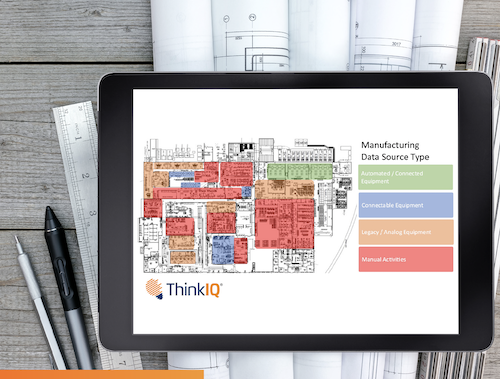
Smart Manufacturing, also known as Industry 4.0, is revolutionizing manufacturing safety and efficiency. In this blog, we delve into four critical elements required of a Smart Manufacturing system: Visibility, Integrated Data, Robust Analytics, and Aligned, Proactive and Automated Actions.
Visibility - Smart Manufacturing Element 1
You can’t manage what you can’t manage… and you can’ t manage what you can’t see. So management — and thus manufacturing efficiency — relies on the ability to see and manage all elements involved in a manufacturing process.
While newer manufacturing equipment is usually designed to capture and send data, it is crucial to account for legacy devices, analog processes, hand-manufacturing, and adjacent activities.
Often, for example, a Smart Manufacturing partner will add IoT devices on existing legacy equipment to capture data that wouldn’t normally be captured. For example, an older oven system could have an IoT temperature unit attached, giving realtime digital oven temperature data. Or a door sensor could be added to a unit, indicating how often and how long the door had been opened.
In addition, today’s vision systems can be implemented. They convert camera data into digital information which, once processed, can greatly increase visibility. Processed data could, for example, include monitoring employee safety, such as identifying proper (and improper) lifting techniques. Or it could visualize and give realtime digital data on the production of handcrafted items, such as a wood statues, guitars, or hand-assembled subproducts.
By implementing comprehensive visibility, organizations can create a strong foundation for effective Industry 4.0 implementation to enhance manufacturing efficiency.
Integrated Data - Smart Manufacturing Element 2
You can’t manage what you can’t manage… and you can’ t manage what you can’t see. So management — and thus manufacturing efficiency — relies on the ability to see and manage all elements involved in a manufacturing process.
While newer manufacturing equipment is usually designed to capture and send data, it is crucial to account for legacy devices, analog processes, hand-manufacturing, and adjacent activities.
Often, for example, a Smart Manufacturing partner will add IoT devices on existing legacy equipment to capture data that wouldn’t normally be captured. For example, an older oven system could have an IoT temperature unit attached, giving realtime digital oven temperature data. Or a door sensor could be added to a unit, indicating how often and how long the door had been opened.
In addition, today’s vision systems can be implemented. They convert camera data into digital information which, once processed, can greatly increase visibility. Processed data could, for example, include monitoring employee safety, such as identifying proper (and improper) lifting techniques. Or it could visualize and give realtime digital data on the production of handcrafted items, such as a wood statues, guitars, or hand-assembled subproducts.
By implementing comprehensive visibility, organizations can create a strong foundation for effective Industry 4.0 implementation to enhance manufacturing efficiency.
Robust Analytics - Smart Manufacturing Element 3
Once the data is integrated and standardized, the power of Industry 4.0 Smart Manufacturing is unleashed through robust analytics. Machine Learning and AI can analyze historical patterns and current data, making accurate predictions about future outcomes and suggesting improvements. For example, AI algorithms can predict equipment failure based on historical data, or can allow a manufacturer to see exactly why output has decreased (or increased) at a certain point in time.
This element of Smart Manufacturing allows companies to begin to pinpoint critical insights from a sea of data, ultimately enhancing manufacturing efficiency and safety.
Aligned, Proactive And Automated Actions - Smart Manufacturing Element 4
The final element of Smart Manufacturing is for the Smart Manufacturing system to provide or create actions in alignment with corporate goals. Insights gained through visibility, integrated data, and robust analytics can be proactively suggested to human operators, or implemented automatically.
First, though, Smart Manufacturing systems must understand a company's goals across safety, efficiency, and other metrics to provide relevant predictions and recommendations. Then, the system can analyze historical activities and results, as well as test hypothetical situations, to make predictions. (Incredibly, these systems also become smarter over time, giving early adopters a significant advantage.)
For example, a system may identify a previously unidentified bottleneck in the production line. It could then test scenarios, ultimately suggesting the best adjustments to improve throughput and manufacturing efficiency. In one famous example, the Smart Manufacturing system provided data that allowed an onion ring manufacturer to modify how it’s onions were supplied to increase materials efficiency by more than 7%.
Integrating automated actions within the system enables continuous improvement without manual intervention, such as automatically adjusting machine settings to optimize production speed while maintaining product quality.
This element fully brings the benefits of Industry 4.0 to life, driving improved manufacturing efficiency and safety.
The four elements of Smart Manufacturing — Visibility, Integrated Data, Robust Analytics, and Aligned, Proactive and Automated Actions — work together to improve manufacturing efficiency and safety for Industry 4.0 manufacturers.
ThinkIQ is a leading provider of Transformational Intelligence solutions for manufacturers, helping businesses embrace the power of Industry 4.0 and enhance their manufacturing efficiency and safety. With a proven track record in contextualizing data and delivering actionable insights, ThinkIQ empowers organizations to make data-driven decisions and unlock the full potential of Smart Manufacturing.
Are you ready to harness the power of Industry 4.0 and improve your manufacturing efficiency and safety? Contact ThinkIQ today to discuss the steps to becoming an Industry 4.0 Smart Manufacturer … and to start reaping the benefits of these four essential elements >


